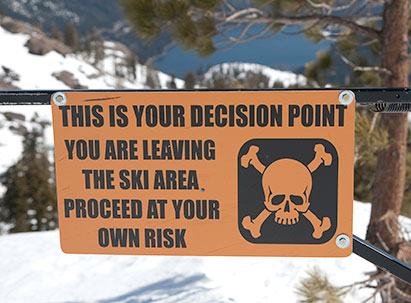
To understand persistant slab, let’s first start talking about snowpack. What is snowpack? Basically, it’s the snow “packed” down sitting on the mountain. You know, the stuff the sharp side of your deck slices like fresh baked bread while your silly ass pretends to fly.
Snowpack is composed of various layers. The layers form when progressive storms leave snow sitting long enough to form cohesive chunks. Through the winter as snow continues to fall on the slope, new layers are continually set. These layers eventually form bonds with one another like the icing binds the layers of a cake. The slab avalanche occurs when one layer in the snowpack breaks its bond with another weaker layer below, unleashing an awesome tour de force from our old friend gravity. Depending where this avalanche is going, it has the power to kill you.
A persistant slab forms in the snowpack when a stronger heavier layer of snow rests on a weaker layer below. Under stress, the weak layer is liable to break it’s bond with the upper layer and release an avalanche. Nobody wants to get caught in avalanche, even if you have one of these nifty flotation backpacks by BCA.
So how do you protect yourself from persistant slab in the backcountry?
- Stay up to date on weather conditions in the mountains throughout the season. If possible, check avalanche reports before heading up.
- Before you set out on the trail, with your backcountry team, make a plan based on your knowledge of the conditions. What is probably going to be cool to hit? What is not going to be cool to hit? Write it down and refer back when in the field.
- Recognize signs of instability in the snow packs ie. “wumfing”, propagation of cracks, facets, warm temperatures, angle of the slope, aspect or slope direction to the sun.
- Dig a snow pit to examine firsthand the layers of the snowpack, looking for weak layers or faceting that may increase the risk of slab avalanche.
- Whenever you encounter a slope of significant grade in the backcountry, take a second to weigh out risk vs reward before entering any potential avalanche terrain. Also, be prepared to tell your friends to shut it if you know they are being foolish.
When you enter the backcountry, you must trust yourself and your team to make good decisions or else you should stick to something safer. It’s not that hard, but it’s also not always that easy. The best way to cover your bases before going out into the backcountry is to take AIARE”s Level One avalanche safety certification course offered by SGT education program in Argentina this summer!
